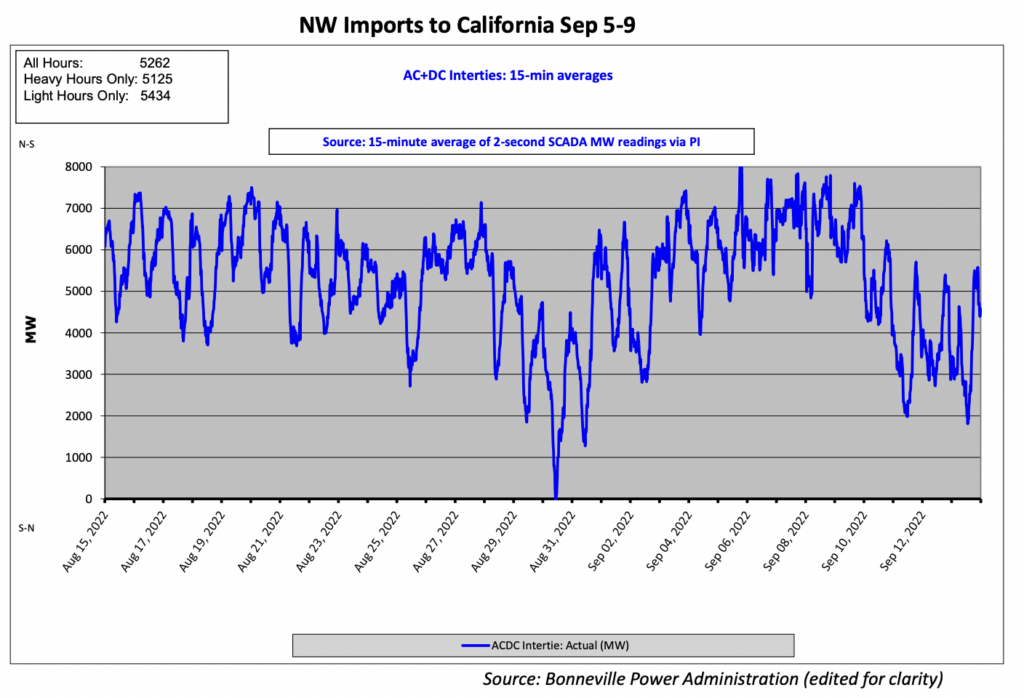Customer Resources Play a Key Role During Extreme Weather
An in-depth look at what the Pacific Northwest can learn from the role of customer side resources in saving the grid.
The West is in a transformative time, decarbonizing our energy system while electrifying large aspects of our economy, such as transportation and heating and cooling of buildings. California, more than any other state, is in the midst of balancing aggressive carbon reduction and clean energy targets while maintaining a reliable and affordable energy system. Sustaining that balance requires complex planning and sound decision-making. In California’s case, controversy over extending the operation of Diablo Canyon Nuclear Power Plant and once-through cooling of several gas plants exemplify the complexity of their situation.
As the Northwest’s own carbon and clean energy requirements kick in, we must plan for the multifaceted clean energy system that is inevitably just a few years down the road. We can learn from California, use their lessons to plan for a reliable and affordable grid, and accelerate clean energy resource development, such as the customer side resources that helped save the day in California.
For about a week in early September, electricity grid operators in California were sweating from more than just the heatwave that enveloped the West. There was speculation that multiple days of one hundred-plus degree heat would stretch the grid to its maximum capacity, resulting in large but limited outages.
However, the California Independent System Operator (CAISO), the entity that manages most of California’s grid, avoided limited outages. While working to get every available power plant online, CAISO also demonstrated that customer side resources, such as demand response, energy storage, and energy efficiency, can be valuable and affordable tools. In stress conditions, customer side resources are crucial to keeping the power on during climate change-driven extreme weather events.
What can the Pacific Northwest learn from this case study on grid reliability as we grapple with our own extreme weather events?

Demand response can help maintain a reliable grid, especially in extended extreme weather events.
On Tuesday, September 6, the California grid smashed its previous peak electricity demand record.
To address this critical situation, CAISO utilized significant customer side resources, like conservation, demand response, and storage, in a coordinated manner, just as we encourage grid operators to do in our series, The Harmonious Grid.

Earlier in the week, under the same heatwave, several demand response programs that CAISO tapped into helped maintain a reliable grid. CAISO issued daily Flex Alerts to encourage consumers to conserve electricity, resulting in about 1,000 MW of savings. CAISO also saved 2,000 MW of power by tapping into demand response programs, such as the new Emergency Load Reduction Program (ELRP), which pays customers to reduce their electricity use during an emergency grid situation. California learned from previous grid emergencies, such as the 2020 blackouts, and is creating new demand response programs like the ELRP that helped saved the day for multiple days during this extreme weather.
However, on September 6, it was clear that peak demand was still going to be higher than supply, and Governor Newsom issued a wireless emergency alert to all Californians to conserve electricity. The alert resulted in an additional 2,000 – 2,500 MW of conservation in less than thirty minutes (see Figure 2). This dramatic tactic had a huge impact as Californians heeded the call quickly – but it’s not something that can be done in every high demand period.

California has learned from past grid emergencies and is showing that carefully managing customer demand can help maintain a reliable grid while continuing to develop new programs. For example, California’s Demand Side Grid Support Program, which was passed by the Legislature in 2022, will help CAISO continue to manage the grid more flexibly and effectively, especially during grid emergencies. The Pacific Northwest can learn lessons from these programs and accelerate adoption of demand response programs to benefit our grid and reduce usage during peak times.
Energy storage is key for short term capacity reserves.
Demand response was not the only customer side resource that helped maintain a reliable grid during this heatwave. Elliot Mainzer, CEO and President of CAISO, explained that “the thousands of megawatts of new clean energy resources, including 3,300 MW of batteries that California has added to its grid since July 2020 were unquestionably helpful.” As seen in Figure 3, batteries discharged over 3,000 MW of electricity during the evening peak demand on September 5, keeping the grid reliable. California’s wide-ranging use of energy storage goes back to the passage of Assembly Bill 2514 in 2010, a time when few policymakers were thinking about energy storage at such a large scale.

Today, cost-effective energy storage is most often procured as a solution for short period peaks in demand of up to four hours. Battery storage is a vital component of future power systems when it is used in conjunction with other customer side resources.
Furthermore, energy storage more broadly is a fledgling technology, outside of hydro storage. Many different forms of batteries and storage technologies are competing for market share. Which technologies will prevail for each distinctive use, including long duration storage, is still emerging. What is clear is that costs are rapidly coming down and energy storage will play a growing role in a decarbonized grid.
The Pacific Northwest is lucky that it has a huge hydropower system that can often serve like a battery. However, with climate change, we cannot rely just on our hydropower system at all times, especially in late summer when drought and heat waves are expected. Our region should be strategically investing in energy storage to support peak energy use and avoid power system failure during extreme weather events in both the winter and summer.
Aggressive and consistent investment in energy efficiency should be resource number one to reduce peak loads to help maintain a reliable grid.
California has been a leader in energy efficiency starting in the 1970s, and the benefits of reduced loads are paying off. California saved 4,140 GWh of electricity from energy efficiency in 2021 — enough to power nearly 370,000 average Californian homes for a year. The state is committed to a doubling of statewide energy efficiency savings by 2030.

The benefits of energy efficiency investments are clear. California’s per capita electricity use has remained flat, while the rest of the US’s per capita electricity use has increased by about 33%. There is no doubt that energy efficiency has reduced electricity loads in California, allowing CAISO to meet demand with less resources. Without decades of energy efficiency investments, California’s new electricity demand record would have been much higher.
Fortunately, the Pacific Northwest also has a long and strong history of energy efficiency adoption. Since 1978, our region has saved more than 7,200 aMW due to energy efficiency, our second largest energy resource (after hydropower). Per capita electricity use in the Northwest has also remained flat due to strong efficiency programs, energy codes, and equipment standards. However, demand for electricity is expected to rapidly grow as electrification and decarbonization advance. We must continue to invest in energy efficiency to keep our peak demands in check and maintain reliability. Energy efficiency should be the first resource to procure as we decarbonize the grid and our energy system.
Greater coordination and resource sharing across the West facilitates geographic diversity of resources, enhancing reliability for everyone.
California’s transmission connections to other regions greatly enhanced the reliability of their grid, as our friend Ralph Cavanagh at Natural Resources Defense Council pointed out. Ralph explains that California’s interconnections to other regions can carry about 20,000 MW, almost 40% of the record peak electricity demand on September 6. That access allows California to tap into and enhance geographic diversity of clean energy resources. For example, see Figure 5: the transmission lines connecting California to the Pacific Northwest were carrying 4,500 to 8,000 MW of electricity southward, during the most dire hours on the grid.

Without those interconnections, which allowed California to access energy produced in regions without a heatwave, California may have been forced to resort to limited outages. Resource sharing across large geographies allows all parties to tap into a greater diversity of resources, helping maintain system reliability when one region experiences extreme weather and peak usage conditions.
The Pacific Northwest, along with our partners across the West, should continue to explore a West-wide electricity market structure that will build on the proven successes of resource sharing shown in the Western Energy Imbalance Market. The benefits for the West are too immense to allow a West-wide market structure to fail.

We don’t need fossil fuel resources to maintain a reliable grid – demand side resources are better.
As explained in the Harmonious Grid series, technological innovations are transforming the power grid into a multi-directional, interactive system. California is in the beginning stages of this transformation, and we recognize that both gas plants and Diablo Nuclear Power Plant received operating extensions due to reliability concerns. However, if we embrace this new system of shaping and managing demand, we will be able to shift off fossil fuel electricity generation quicker and easier, with more benefits for customers and utilities. California’s experience shows that a more Harmonious Grid gives grid operators better control in maintaining a reliable grid, especially in times of emergency. CAISO was able to manage the largest electricity demand peak in California’s history, with the help of customer side resources such as demand response, energy storage, and energy efficiency.
We will have to shift how the grid is operated and rethink how we invest in new energy resources, but the alternative is building new, expensive, and dirty gas peaker plants that only run for a few days all year during extreme weather events. A flexible, decarbonized power grid with ample customer side resources provides numerous benefits for both customers and utilities.
We hope the Pacific Northwest learns from the experiences of our neighbors to the south in prioritizing customer side resources so that we can enjoy the benefits of a reliable, flexible, diversified, and affordable energy grid.

